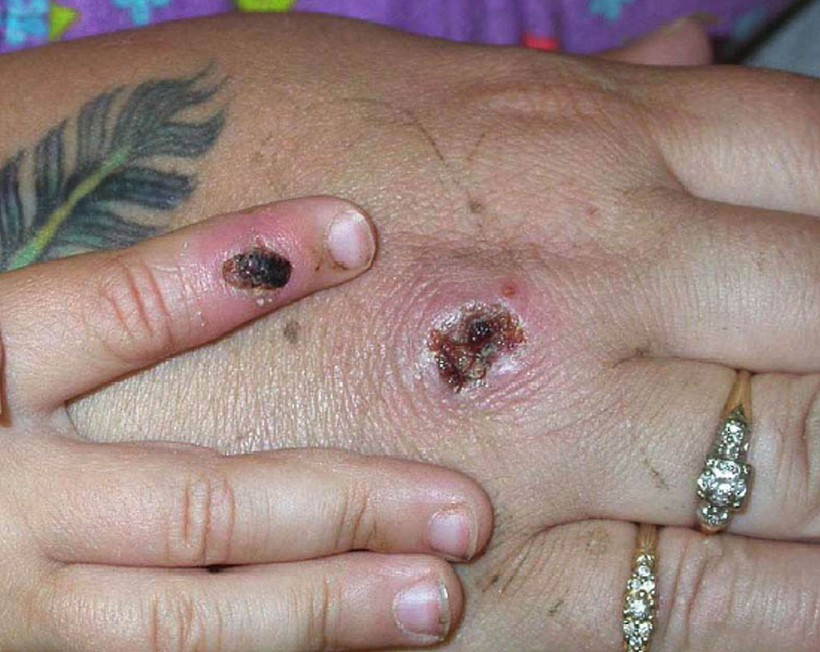Despite what you may have read in misleading headlines and speculative social media posts, scientists say monkeypox is neither a sexually transmitted disease (STD) nor "a gay disease."
According to health officials, monkeypox cases in Europe and North America have mostly - but not entirely - been detected among males who have sex with men. Many of these cases were discovered when men went to sexual health clinics for assistance with lesions on their genitalia.

UNDATED ? JUNE 5: In this Centers for Disease Control and Prevention handout graphic, symptoms of one of the first known cases of the monkeypox virus are shown on a patient?s hand June 5, 2003. The CDC said the viral disease monkeypox, thought to be spread by prairie dogs, has been detected in the Americas for the first time with about 20 cases reported in Wisconsin, Illinois, and Indiana.
Scientists Say Monkeypox Is Not An STD
Some reporting on the monkeypox outbreaks has been used to "reinforce homophobic and racist stereotypes and exacerbate stigma," according to UNAIDS, which emphasizes that the danger is not confined to males who have sex with men.
When people consider the failures of the HIV epidemic in the early 1980s, it's simple to understand how stigma and preconceptions exacerbated an already awful situation.
"Stigma and blame undermine trust and capacity to respond effectively during outbreaks like this one," said UNAIDS Deputy Executive Director Matthew Kavanagh in a statement.
According to Kavanagh, experience has shown that stigmatizing discourse may swiftly inhibit evidence-based responses. He went on to say that it fostered fear cycles, pushing individuals away from health care, making it challenging to detect instances, and encouraging ineffectual, punitive actions.
"We appreciate the LGBTI community for having led the way on raising awareness - and we reiterate that this disease can affect anyone," Kavanagh added per Newsweek.
ALSO READ: Monkeypox Conspiracy Theories Debunked: 3 Horrifying Assumptions About the Disease That Are False
Common Symptoms Between HIV/AIDS, Monkeypox
Dr. David Heymann, the former head of the World Health Organization's (WHO) emergency department, told the Associated Press that partygoers having sex at raves in Spain, Belgium, and maybe elsewhere in Europe was the leading idea to explain the disease's spread.
Monkeypox transmission appears to be mostly between guys who have intercourse with other men, which is unusual. A virus from the same family as smallpox causes the sickness.
Patients with monkeypox experience fever, achy muscles, enlarged lymph nodes, tiredness, and a rash, which are similar to smallpox symptoms but milder. More apparent signs, such as odd rashes, blisters, and scabs on the skin, occur later.
Interestingly enough, the virus is prevalent in portions of central and western Africa, where it is usually found in rodents - but not in monkeys.
Close contact with infectious material from an infected person's skin lesions and respiratory droplets in prolonged face-to-face contact causes human-to-human transmission. It can also be spread by sharing clothes or bedsheets with an infected individual.
Because sex, by its very nature, includes a lot of intimate skin-to-skin contact, many people believe the virus spreads among persons who have had sexual contact. To put it another way, catching a cold while having sex does not make it an STD.
RELATED ARTICLE: Sexual Transmission of Monkeypox Blamed for Its Global Spread, WHO Official Reveals
Check out more news and information on Monkeypox in Science Times.



![Earth's Quasi-Moon Kamo‘oalewa Could Originate From Lunar Surface Not Asteroid Belt [Study]](https://1721181113.rsc.cdn77.org/data/thumbs/full/53275/89/56/50/40/earths-quasi-moon-kamo-oalewa-could-originate-from-lunar-surface-not-asteroid-belt-study.png)










